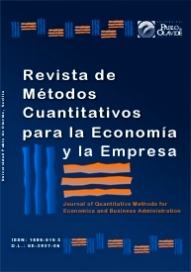Sustainable innovation in manufacturing companies
DOI:
https://doi.org/10.46661/rev.metodoscuant.econ.empresa.10647Keywords:
Sustainable innovation, sustainable transformational leadership, dynamic capabilities sustainable, environmental commitmentAbstract
This study analyzes sustainable innovation in manufacturing companies. The study, with a quantitative cross-sectional approach and a non-experimental research design, used a measurement instrument composed of 21 items, and 304 participants were obtained in the data collection. The information has been analyzed in the statistical packages SPSS, SMART - PLS and AMOS, used to perform the reliability, validity and model fit tests through confirmatory factor analysis. To achieve the model fit, three items were eliminated, obtaining two significant variables: sustainable dynamic capability (X2) and sustainable transformational leadership (X4).
Downloads
References
Albort-Morant G, Leal-Millán A, Cepeda-Carrion G, Henseler J (2018) Developing green innovation performance by fostering of organizational knowledge and coopetitive relations. Review of Managerial Science, 12(2), 499-517.
https://doi.org/10.1007/s11846-017-0270-z
Angulo P, Ochoa C (2023). Estrategias de sostenibilidad para la mayor competitividad en la industria cementera de México. Revista ALCONPAT, 13(2), 254-270.
https://doi.org/10.21041/ra.v13i2.637
Cantú-Mata JL, Torres- Castillo F, Segoviano-Hernández J (2021) PLS-SEM: Modelo Estructural de Desarrollo Sostenible de las Tecnologías de la Información y Comunicación. Interciencia, 46(09/10), 344-353.
Cantú-Mata, J. L., & Torres-Castillo, F. (2022). Desempeño de innovación sostenible y ventaja competitiva sostenible en organizaciones manufactureras. Interciencia, 47(7), 264-270.
Chen YS, Chang CH, Lin YH (2014) Green Transformational leadership and green performance: The mediation effects of green mindfulness and green self-efficacy. Sustainability, 6(10), 6604-6621.
https://doi.org/10.3390/su6106604
Chen, YS, Lin YH, Lin CY, Chang CW (2015) Enhancing green absorptive capacity, green dynamic capacities and green service innovation to improve firm performance: An analysis of structural equation modeling (SEM). Sustainability, 7(11), 15674-15692.
https://doi.org/10.3390/su71115674
Ching-Hsun C, Yu-Shan C (2013) Green organizational identity and green innovation. Management Decision, 51(5), 1056-1070.
https://doi.org/10.1108/MD-09-2011-0314
D'Souza C, Taghian M, Lamb P, Peretiatko R (2007) Green decisions: demographics and consumer understanding of environmental labels. International Journal of Consumer Studies, 31(4), 371-376.
https://doi.org/10.1111/j.1470-6431.2006.00567.x
Hair J, Ringle C, Sarstedt M (2011) PLS-SEM: Indeed a Silver Bullet. Journal of Marketing Theory and Practice, 19 (2): 139-151.
https://doi.org/10.2753/MTP1069-6679190202
Kaiser HF (1974) An index of factorial simplicity. Psychometrika, 39, 31-36.
https://doi.org/10.1007/BF02291575
King N, Anderson N (2003) Como administrar la innovación y el cambio. Guía Crítica para organizadores. Thomson Editores. España. 233 pp.
Lawson B, Samson D (2001) Developing innovation capability in organisations: A dynamic capabilities approach. International journal of innovation management. 5(03), 377-400.
https://doi.org/10.1142/S1363919601000427
Mele C. Russo-Spena T (2015) Eco-innovation practices. Journal of Organizational Change Management. 28(1), 4-25.
https://doi.org/10.1108/JOCM-08-2013-0146
Prabowo H, Sriwidadi T, Ikhsan RB (2021). The influence of dynamic capability on sustainable competitive advantage: An empirical study of small businesses in Indonesia. The Journal of Asian Finance, Economics and Business, 8(6), 949-959.
Schiederig T, Tietze F, Herstatt C (2012) Green innovation in technology and innovation management-an exploratory literature review. R&D Management, 42(2), 180-192.
https://doi.org/10.1111/j.1467-9310.2011.00672.x
Singh S K, Del Giudice M, Chierici R, Graziano D (2020) Green innovation and environmental performance: The role of green transformational leadership and green human resource management. Technological Forecasting and Social Change, 150, 119762.
Published
How to Cite
Issue
Section
License
Copyright (c) 2024 Jose Luis Cantú-Mata

This work is licensed under a Creative Commons Attribution-ShareAlike 4.0 International License.
Submission of manuscripts implies that the work described has not been published before (except in the form of an abstract or as part of thesis), that it is not under consideration for publication elsewhere and that, in case of acceptance, the authors agree to automatic transfer of the copyright to the Journal for its publication and dissemination. Authors retain the authors' right to use and share the article according to a personal or instutional use or scholarly sharing purposes; in addition, they retain patent, trademark and other intellectual property rights (including research data).
All the articles are published in the Journal under the Creative Commons license CC-BY-SA (Attribution-ShareAlike). It is allowed a commercial use of the work (always including the author attribution) and other derivative works, which must be released under the same license as the original work.
Up to Volume 21, this Journal has been licensing the articles under the Creative Commons license CC-BY-SA 3.0 ES. Starting from Volume 22, the Creative Commons license CC-BY-SA 4.0 is used.










